모든이들이 가장 아름답다고 평가하는 아치교의 역사는 수천년이 넘는다. 돌이라는 한정된 재료를 가지고 인류의 조상들은 육중하지만 아름다운 아치교를 많이 건설하였다.
일률적이었던 반원 아치교의 형상을 답습하던 교량 기술자들이 타원형 아치를 본격적으로 적용하기 시작한 시점은 르네상스시대인 16세기로 스팬/라이즈비(l/f)를 1:7 정도까지 하여 시각적으로 아름다운 완만한 아치를 만들기 시작하였다.
Santa Trinita Bridge
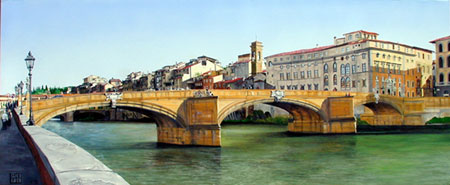
18세기 중반에 아치교는 그 형상에서 또 한 번의 전환을 이루는데 바로 Jean Rodolphe Perronet에 의해서였다. 그는 연속아치의 중간 교각에는 수직 반력만 작용한다는 사실을 인지하여 매우 얇은 교각을 선보였고 스팬/라이즈비를 더 증가시켜 슬렌더한(slender) 형상의 Concorde Bridge, Neuilly Bridge 등 기존 아치교에 비해 경제적이며 날렵한 작품을 남겼다.
일찍 1774년 Sainte Maxen에 span/rise比(l/f)=23.40:2m인 아치교를 세웠다. 그는 세느강의 다리를 설계할 때 l:f=30.20:2.77m=11.20을 제시하였다. 관계당국자는 이러한 걸작품을 내어 놓는 용기에 소스라치게 놀랐으며, 관계장관은 그에게 아치고를 3.97m(l/f=8)로 할 것을 강압했다. [석축 아치 교량 이야기]
The full potential of the elliptical arch was realized by a French engineer of Swiss ancestry, Jean-Rodolphe Perronet (1708–1794). While observing the slight tilt of the pier of a bridge under construction, Perronet realized that much of the stability of a completed arch bridge results from the transference of compressive forces through the bridge and towards its abutments. Perronet also understood that these forces could be made more horizontal by building bridges with arches that were as flat as possible. Perronet used these principles to design bridges with piers of unprecedented slimness. These slender piers conferred a number of advantages. In addition to saving material, the thin piers widened the waterways between them, facilitating the movements of boats on the river. Wider waterways also reduced the current passing through them, so less damage was done to the piers by the scouring action of the river’s current. [Arch Bridge]
Concorde Bridge
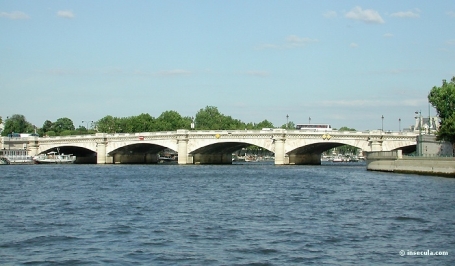
*Images from insecula.com
돌을 이용한 아치교의 건설은 콘크리트라는 새로운 재료의 출현으로 서서히 종말을 고하고 20세기 위대한 교량 기술자인 Robert Maillart를 탄생시킨다. 1899년 작품인 Stauffacher Bridge만 보더라도 외관상 전통적인 아치교와 비교해서 별다른 특징을 발견할 수 없다.
Stauffacher Bridge

그러나 1901년 3-힌지 개념을 도입한 Zuoz Bridge를 시작으로 천재성을 꽃 피우기 시작한다. 정밀한 계산 과정없이 단순한 도해법(graphical analysis)으로 설계했던 Zuoz Bridge는 건설 후 교대측 벽에서 균열이 발생했고 그 문제점을 도출해나가는 과정에서 그는 새로운 형상의 아치교를 선보인다.
Zuoz Bridge의 균열 양상

Zuoz Bridge의 교대측 벽에 발생한 균열이 구조적으로 중요치 않음을 인식하고 더 나아가 이 벽체가 무용함을 알게 되며, 이를 발전시켜 아치 구조의 새로운 장을 여는 1905년 Tavanasa Bridge를 만든다. 그러나 이러한 새로운 형식의 교량에 대해 관계자들은 Jean Rodolphe Perronet가 그 당시 받았던 그런 평가를 내렸고, 큰 주목을 받지 못하자 관심을 건축으로 돌려 1920년대까지 교량을 설계하지 않았다.
Maillart’s design for the Zuoz Bridge had vertical walls, extending right to the abutments, which he imagined to be part of his hollow box. Such full-depth walls had been a crucial feature of ancient Roman bridges, even though they are structurally inefficient and sometimes require extra maintenance.
During the nineteenth century, such walls gradually became useless, but the image of “appropriate” form persisted even for Maillart until he noticed cracks at Zuoz in 1903. He realized immediately that these cracks were not dangerous for his reinforced concrete bridge. He further recognized that walls near the abutments were structurally useless. [The Art of Structural Design]
BMD of 3-Hinged Arch

3-Hinged Arch의 휨모멘트 형상으로 만든 Tavanasa Bridge

잠시 교량설계에서 물러났던 그는 1923년 진일보된 교량형식인, spandrel 부분을 수직재로 상판과 아치리브를 연결하여 마치 현수교를 뒤집어 놓은 듯한 형상으로 아치 리브는 압축력만 받게한, Flienglibach Bridge로 다시 복귀하며 교량사에 남는 작품들을 만들어 낸다.
교량사에서 Robert Maillart는 콘크리트라는 신소재를 가지고 structural efficiency를 고려하여 art와 engineering의 조화를 이루게 교량을 설계한 첫 인물로 평가받고 있다. 많은 작품들 중에서 깊은 계곡에 그림같이 걸려 있는 듯한 모습으로 그 조형미가 전세계적으로 널리 알려진, 1991년 International civil engineering historic landmark로 지정된 Salginatobel Bridge를 그의 대표작으로 꼽는다.
‘건축상의 미관은 효과적인 구조거동에 반하여서는 성립될 수 없다. (Architectural elegance could not be achieved against the need of an efficient structural behavior)’
-Norman Foster-
Salginatobel Bridge
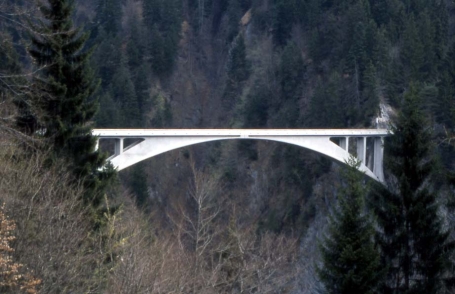
International civil engineering historic landmark
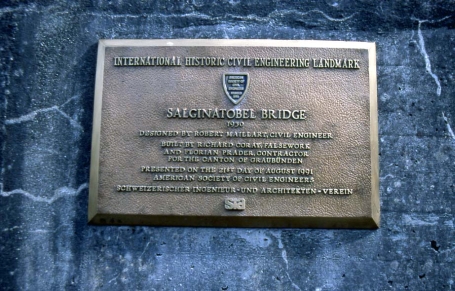
전체공사비 의 1/4이 투입된 Salginatobel Bridge 가시설
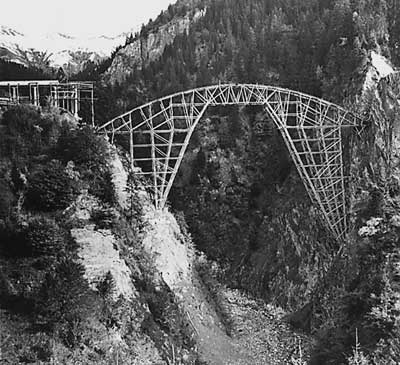
*Images from nbq.ch/daniel
2 Trackbacks
Salginatobel Bridge…
Robert Maillart의 대표작인 Salginatobel Bridge
Maillart’s best-known structure is the Salginatobel Bridge, completed in 1930. The design was based on the hollow-box arch of the destroyed Tavanasa Bridge, but with refinements: Maillart eliminated……
Schwandbach Bridge…
Robert Maillart의 ‘thinness’에 대한 열정은 ‘deck-stiffened arch’라는 새로운 형식의 교량인 Flienglibach Bridge를 탄생시키고 Schwandbach Bridge에서 그 절정을 이루게 된다. (아치 리브의 두께……